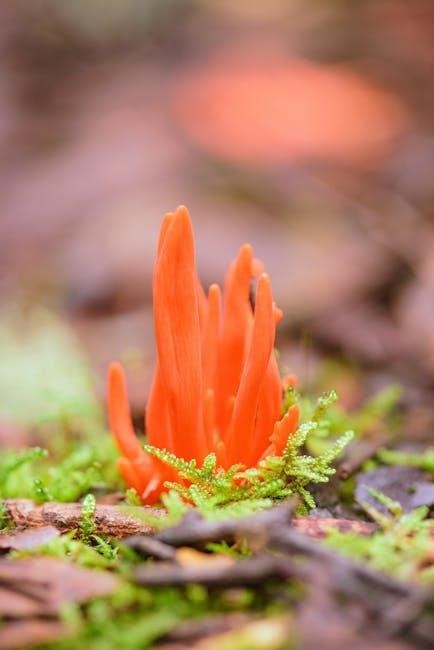Colorado is renowned for its rich mycological diversity, offering a wide variety of mushrooms, from edible delicacies to toxic species, making identification essential for safe exploration and enjoyment.
1.1 Overview of Colorado’s Mycological Diversity
Colorado boasts an extraordinary variety of mushrooms, with over 5,000 species documented. From edible delicacies like chanterelles and morels to toxic varieties such as Amanita, the state’s diverse ecosystems support a wide range of fungal life; High-elevation forests, meadows, and mountain regions create unique habitats for both rare and common species, making Colorado a hotspot for mycological exploration and study.
1.2 Importance of Mushroom Identification
Accurate mushroom identification is crucial in Colorado due to the presence of both edible and deadly species. Misidentification can lead to severe health risks, including life-threatening poisoning. Understanding key characteristics, habitats, and expert guidelines ensures safe foraging and responsible enjoyment of Colorado’s diverse fungal bounty.
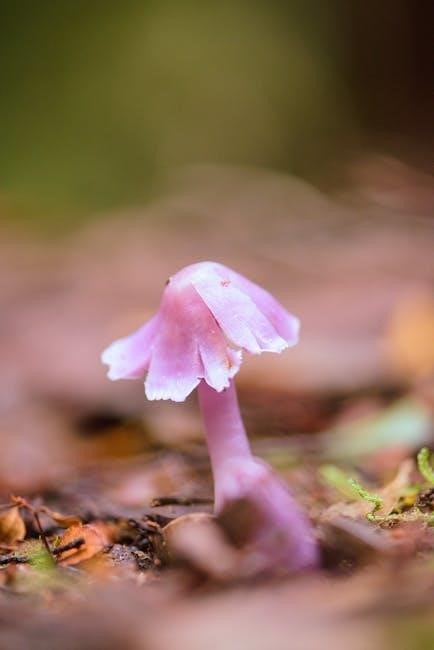
Common Edible Mushrooms in Colorado
Colorado offers a variety of edible mushrooms, including prized species like Boletes, Chanterelles, and Morels, each valued for their unique flavors and culinary versatility, attracting both locals and visitors.
2.1 Popular Edible Species
Colorado’s forests are abundant with popular edible mushrooms like the golden Chanterelle, prized for its fruity aroma, and the Porcini, sought after for its rich, earthy flavor. Morels, with their unique honeycomb appearance, are highly coveted, while Oyster mushrooms and Boletes add to the state’s diverse culinary offerings, making it a forager’s paradise.
2.2 Habitats and Foraging Tips
Colorado’s mixed conifer forests, particularly at high elevations, are prime foraging grounds for mushrooms. Look for species like Chanterelles and Boletes in areas with rich soil and decaying wood. Streams, meadows, and burned areas also yield hidden gems. Timing is crucial, with the season typically running from April to September, peaking in late summer. Always prioritize sustainable harvesting to preserve these delicate ecosystems for future forayers. Colorado’s diverse landscapes offer endless opportunities for mushroom enthusiasts to explore and discover. By understanding the specific habitats and conditions, foragers can successfully locate and responsibly collect Colorado’s bounty of wild mushrooms. Additionally, knowing the types of trees and soil conditions can help in identifying the best spots for different species. For example, certain mushrooms thrive near Aspen groves, while others prefer the shade of Spruce-Fir stands. Seasonal weather patterns and recent rainfall also play a significant role in mushroom growth, making timing and location key to a successful foraging experience. With the right knowledge and tools, anyone can enjoy the rewarding hobby of mushroom hunting in Colorado’s vast and varied wilderness. The state’s unique combination of elevation, climate, and vegetation creates a rich environment for a wide variety of mushrooms, making it a must-visit destination for both beginners and experienced foragers alike. The abundance of edible species, paired with the need for careful identification, ensures that Colorado remains a focal point for mushroom enthusiasts. Whether you’re searching for a culinary delicacy or simply exploring nature, Colorado’s mushrooms offer a fascinating and rewarding experience. So, grab your basket, head into the woods, and uncover the hidden treasures of Colorado’s mycological world. The forests are waiting, and the mushrooms are ready to be discovered. With each season bringing new growth and opportunities, Colorado’s mushroom hunting scene continues to captivate adventurers and nature lovers alike. The thrill of the hunt, combined with the beauty of the Rocky Mountains, makes every foraging trip an unforgettable experience. So, get out there and start exploring—Colorado’s mushrooms are waiting for you! The diverse range of species, from the prized Morel to the flavorful Porcini, ensures that there’s always something new to find. And with the right guides and resources, anyone can become a skilled mushroom hunter. Colorado’s natural beauty and mycological richness make it the perfect place to connect with nature and enjoy the bounty of the wild. The state’s commitment to conservation and sustainability also ensures that future generations can continue to enjoy this rewarding hobby. So, whether you’re a local or just visiting, Colorado’s mushrooms are sure to captivate and inspire. The combination of scenic landscapes and culinary delights creates a unique experience that blends adventure with gastronomy. And with the growing interest in foraging, there’s never been a better time to explore Colorado’s mushroom world. The state’s vibrant community of mushroom enthusiasts is always eager to share knowledge and tips, making it easy for newcomers to join in. So, take the first step, grab your gear, and dive into the fascinating world of Colorado mushrooms. The adventure awaits, and the rewards are well worth the effort. With each mushroom you find, you’ll gain a deeper appreciation for the natural world and the incredible diversity it holds. Colorado’s mushrooms are more than just a delicacy—they’re a gateway to a richer connection with the environment. And as you explore the forests and meadows, you’ll discover the true magic of mushroom hunting in Colorado. The state’s unique ecosystems support a wide variety of species, each with its own unique characteristics and growth habits; From the golden Chanterelle to the elusive Morel, every mushroom tells a story of the land and its cycles. By learning about these species and their habitats, foragers can better appreciate the intricate balance of nature. And with responsible practices, they can help preserve this balance for years to come. So, embrace the challenge, enjoy the journey, and savor the flavors of Colorado’s wild mushrooms. The experience is sure to leave you with lasting memories and a deeper appreciation for the natural world. The thrill of the hunt, the beauty of the surroundings, and the joy of discovery all come together in Colorado’s mushroom country; Whether you’re a seasoned pro or just starting out, there’s always something new to explore and discover. And with the right mindset and knowledge, every trip can be a successful and enjoyable one. So, get out there and start foraging—Colorado’s mushrooms are waiting for you! The state’s vast wilderness areas, national forests, and public lands provide endless opportunities for mushroom hunting. From the high-altitude meadows to the lush river valleys, every region has its own unique species and habitats. And with the changing seasons, the landscape is constantly evolving, offering new challenges and rewards for foragers. The diverse range of ecosystems ensures that there’s always something in season, making Colorado a year-round destination for mushroom enthusiasts. Whether you’re searching for a specific species or simply enjoying the adventure, the state’s natural beauty and mycological richness are sure to captivate; So, pack your bags, grab your gear, and head into the Colorado wilderness—your next mushroom adventure is just around the corner. The combination of stunning landscapes, diverse species, and vibrant communities makes Colorado a must-visit place for anyone passionate about mushrooms. And as you explore the state’s vast and varied environments, you’ll discover why it’s a favorite among foragers and nature lovers alike. So, take the first step, embrace the unknown, and let the journey begin. The world of Colorado mushrooms is waiting for you, full of surprises and delights that will leave you eager for more. With each new discovery, you’ll gain a deeper understanding of the natural world and the incredible bounty it provides. And as you share your experiences with others, you’ll become part of a thriving community that values sustainability, exploration, and the joy of the hunt. So, don’t wait—start your Colorado mushroom adventure today and see what wonders the state has in store for you. The journey is just beginning, and the possibilities are endless. The forests, meadows, and mountains of Colorado hold secrets and surprises that only reveal themselves to those who venture into the wild. And with the right spirit and determination, you can uncover them all. So, lace up your boots, grab your basket, and head into the Colorado wilderness—your next great adventure is just a step away. The mushrooms are waiting, and the journey is yours to take. Colorado’s natural beauty and mycological diversity ensure that every foraging trip is an unforgettable experience. Whether you’re searching for a rare species or simply enjoying the thrill of the hunt, the state’s landscapes and ecosystems will captivate and inspire. So, take the first step, embrace the unknown, and let the adventure begin. The world of Colorado mushrooms is full of surprises, and with the right mindset, you’ll be ready to take on whatever comes your way. The journey is just beginning, and the possibilities are endless. So, get out there and start exploring—Colorado’s mushrooms are waiting for you! The state’s unique combination of geography, climate, and biodiversity creates a perfect environment for a wide variety of mushroom species. From the towering peaks of the Rockies to the rolling hills of the plains, every region has its own unique characteristics and hidden treasures. And with the changing seasons, the landscape is constantly evolving, offering new challenges and opportunities for foragers. The diverse range of ecosystems ensures that there’s always something in season, making Colorado a year-round destination for mushroom enthusiasts. Whether you’re a local or just visiting, the state’s natural beauty and mycological richness are sure to captivate. So, pack your bags, grab your gear, and head into the Colorado wilderness—your next mushroom adventure is just around the corner. The combination of stunning landscapes, diverse species, and vibrant communities makes Colorado a must-visit place for anyone passionate about mushrooms. And as you explore the state’s vast and varied environments, you’ll discover why it’s a favorite among foragers and nature lovers alike. So, take the first step, embrace the unknown, and let the journey begin. The world of Colorado mushrooms is waiting for you, full of surprises and delights that will leave you eager
2.3 Culinary Uses and Recipes
Colorado’s wild mushrooms add unique flavors to various dishes, from savory risottos to hearty stews. Chanterelles shine in creamy sauces, while Porcini enhance pasta and pizza. Oyster mushrooms are perfect for stir-fries, and Morels are a delicacy when sautéed in butter. Experiment with pairing mushrooms with locally sourced ingredients like artisanal cheeses and wild herbs for a truly Colorado-inspired culinary experience. These recipes highlight the state’s mycological bounty, offering a flavorful journey through its forests and kitchens.
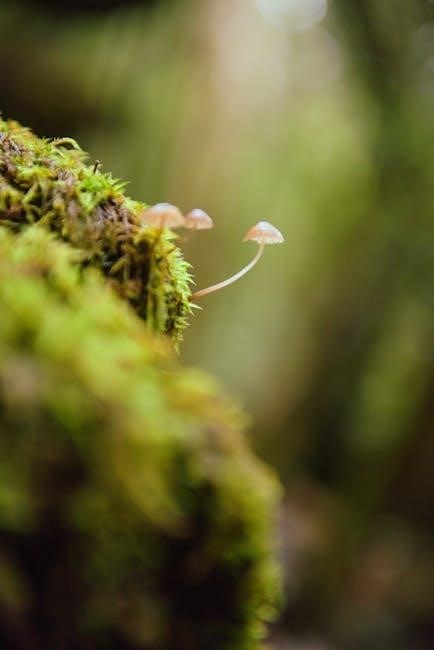
Toxic and Dangerous Mushrooms in Colorado
Colorado is home to several deadly mushroom species, including the destructive Amanita and false morels, which can cause severe illness or death if ingested, emphasizing the need for caution and expert identification when foraging.
3.1 Potentially Deadly Species
Colorado is home to several potentially deadly mushroom species, including the Death Cap (Amanita phalloides), Destroying Angel (Amanita virosa), and Conocybe filaris. These mushrooms can cause severe illness or death if ingested. Additionally, the False Morel (Gyromitra esculenta) contains toxins that require proper preparation. Expert identification is crucial to avoid fatal mistakes while foraging in the state’s diverse ecosystems.
3.2 Safety Guidelines for Foragers
- Always consult with an expert or trusted field guide before eating any wild mushroom.
- Avoid eating raw or uncooked mushrooms, as some species require proper preparation.
- Never forage in polluted or contaminated areas, as mushrooms can absorb toxins.
- Be cautious of look-alike species, as some can be deadly.
- Forage responsibly to avoid over-harvesting and protect ecosystems.
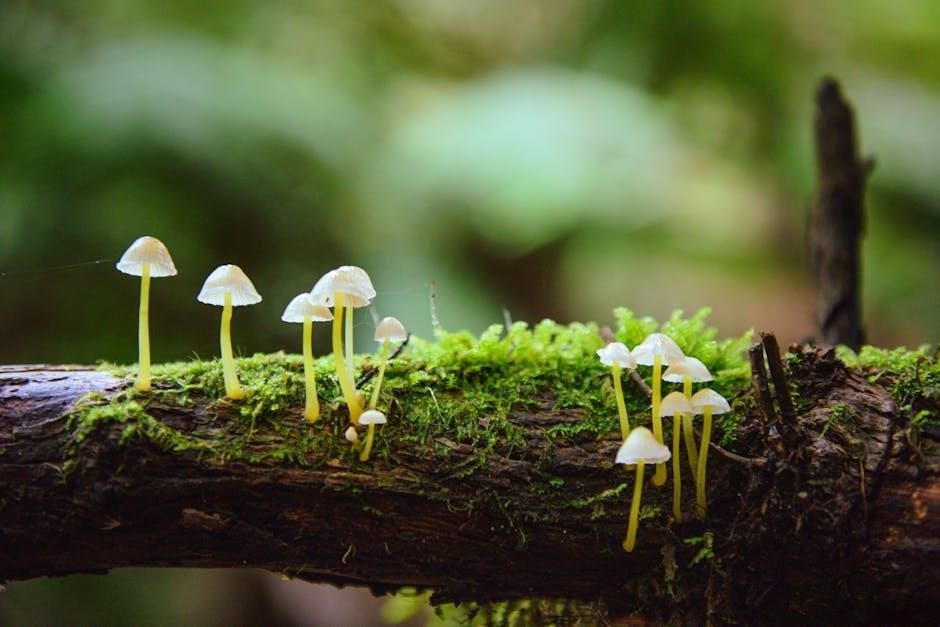
A Guide to Mushroom Hunting in Colorado
Colorado offers diverse habitats for mushroom hunting, with rich forests and meadows. Peak seasons vary, but summer and fall are ideal for discovering species like chanterelles and boletes.
4.1 Best Locations for Mushroom Foraging
Colorado’s diverse landscapes offer prime mushroom-foraging spots. High-elevation forests, such as aspen and conifer groves, are hotspots for species like chanterelles and boletes. Rocky Mountain National Park, the San Juan Mountains, and riverside areas near the Colorado River are ideal. Meadows and wood edges also hide gems like morels and oyster mushrooms, making Colorado a forager’s paradise.
4.2 Seasonal Timing and Weather Conditions
Mushroom foraging in Colorado peaks during spring and summer, with specific species thriving in different seasons. Morels emerge in early spring after snowmelt, while chanterelles and boletes appear in summer. Consistent rainfall and moderate temperatures encourage growth, making July and August prime months. Weather conditions like humidity and soil moisture significantly influence mushroom activity and distribution across the state.
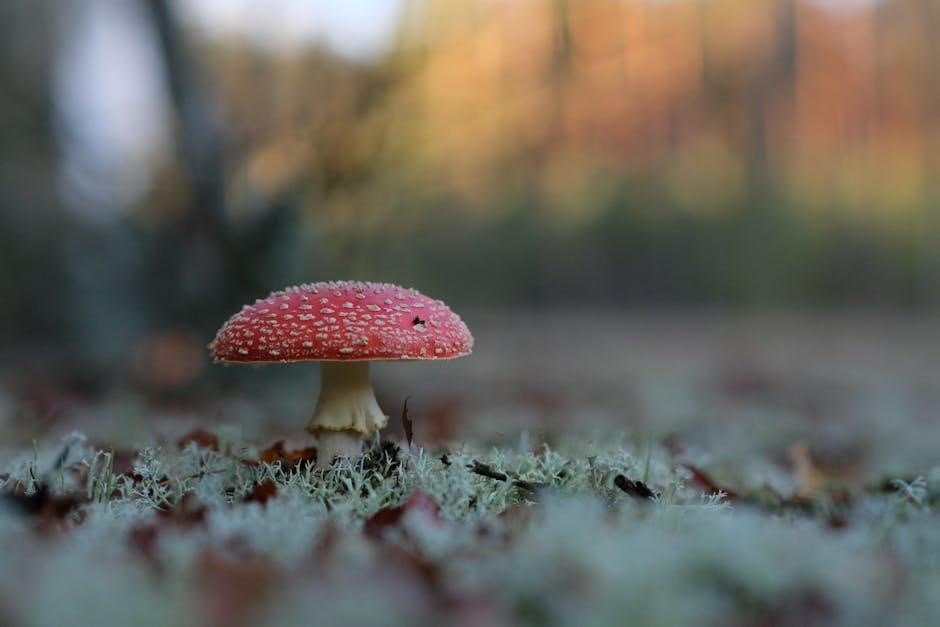
4.3 Essential Tools and Gear
For successful mushroom hunting in Colorado, essential tools include a sturdy basket or bag for collecting, a sharp knife for cutting, and a field guide for identification. A magnifying glass can help examine small features, while wearing long sleeves and sturdy footwear protects against rough terrain. Proper gear ensures a safe and enjoyable foraging experience in Colorado’s diverse landscapes.
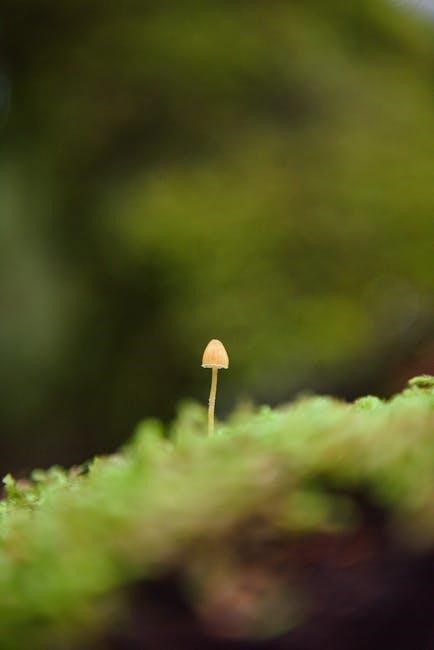
Legal Considerations for Mushroom Enthusiasts
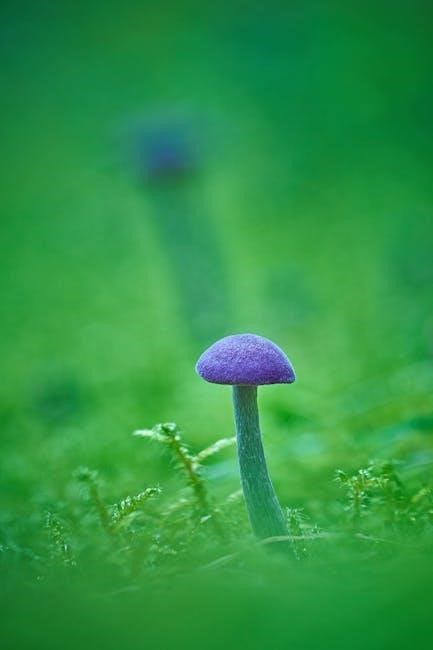
Understanding Colorado’s laws on mushroom collection and possession is crucial. Regulations vary by location, with specific rules for state and national parks, while psychedelic mushrooms remain decriminalized in certain areas.
5.1 Regulations on Mushroom Collection
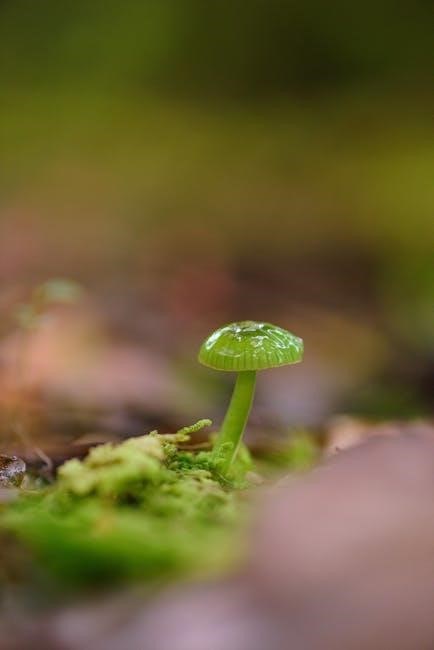
Mushroom collection in Colorado is subject to specific regulations. State and national parks often require permits, while private lands need landowner permission. Commercial harvesting may have stricter rules than personal use. Psychedelic mushrooms, like psilocybin, are decriminalized in some areas but remain illegal under federal law. Always check local ordinances before foraging to ensure compliance and avoid legal issues.
5.2 Legal Status of Psychedelic Mushrooms
In Colorado, psilocybin mushrooms are decriminalized in select jurisdictions, including Denver and Boulder, under local ordinances. However, they remain illegal under federal law. Licensed healing centers are being established to legally facilitate psilocybin use for therapeutic purposes, marking a shift in policy. Users must be 21 or older and adhere to specific regulations to avoid legal consequences.
Conservation and Sustainability Practices
Colorado emphasizes sustainable foraging and education to protect its ecosystems, ensuring biodiversity preservation and the long-term health of its fungal populations for future generations.
6.1 Responsible Foraging Techniques
Adhering to responsible foraging techniques ensures the sustainability of Colorado’s fungal ecosystems. Harvest mushrooms by cutting them at the base to avoid damaging the mycelium. Avoid over-foraging in one area to maintain healthy populations. Use field guides to identify species accurately and always follow local regulations to protect both the environment and future foraging opportunities.
6.2 Protecting Colorado’s Ecosystems
Colorado’s ecosystems are fragile and interconnected. Fungi play a vital role in nutrient cycles and forest health. Over-foraging and habitat disruption can harm both the mushrooms and their environments. To protect these ecosystems, avoid trampling vegetation, refrain from removing large quantities of mushrooms, and minimize disturbances during foraging. Preserving deadwood and leaf litter also helps maintain fungal habitats, ensuring their survival for future generations.
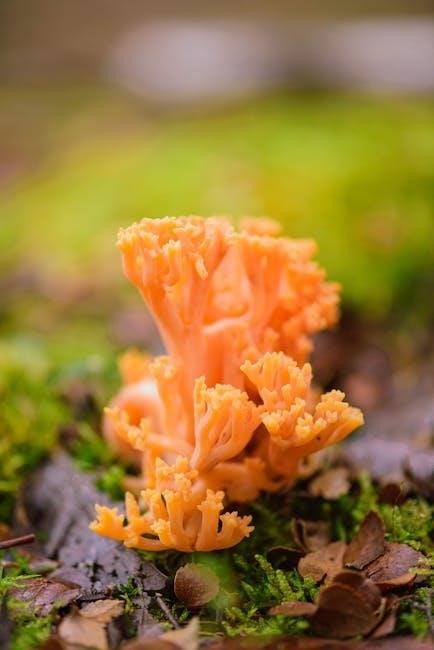
Colorado’s State Mushroom
The Emperor Mushroom (Agaricus julius) is Colorado’s official state mushroom, recognized for its culinary value and ecological significance in the state’s diverse ecosystems and forests.
